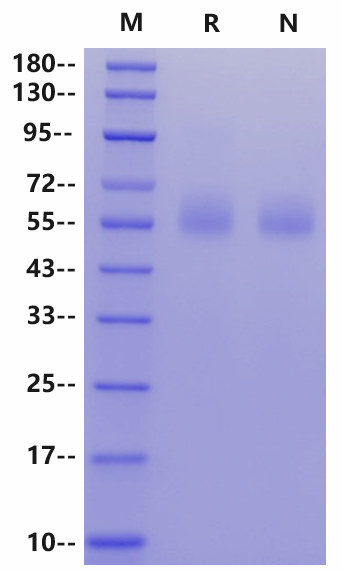Product Details
Product Details
Product Specification
| Species | Human |
| Synonyms | CEACAM8, CD66b, CD67, CGM6, NCA-95 |
| Accession | P31997 |
| Amino Acid Sequence | Gln35-Asp320, with C-terminal 8*His QLTIEAVPSNAAEGKEVLLLVHNLPQDPRGYNWYKGETVDANRRIIGYVISNQQITPGPAYSNRETIYPNASLLMRNVTRNDTGSYTLQVIKLNLMSEEVTGQFSVHPETPKPSISSNNSNPVEDKDAVAFTCEPETQNTTYLWWVNGQSLPVSPRLQLSNGNRTLTLLSVTRNDVGPYECEIQNPASANFSDPVTLNVLYGPDAPTISPSDTYYHAGVNLNLSCHAASNPPSQYSWSVNGTFQQYTQKLFIPNITTKNSGSYACHTTNSATGRNRTTVRMITVSDGGGSHHHHHHHH |
| Expression System | HEK293 |
| Molecular Weight | 50-70kDa |
| Purity | >95% by SDS-PAGE |
| Endotoxin | <0.1EU/μg |
| Conjugation | Unconjugated |
| Tag | His Tag |
| Physical Appearance | Lyophilized Powder |
| Storage Buffer | PBS, pH7.4 |
| Reconstitution | Reconstitute at 0.1-1 mg/ml according to the size in ultrapure water after rapid centrifugation. |
| Stability & Storage | · 12 months from date of receipt, lyophilized powder stored at -20 to -80℃. · 3 months, -20 to -80℃ under sterile conditions after reconstitution. · 1 week, 2 to 8℃ under sterile conditions after reconstitution. · Please avoid repeated freeze-thaw cycles. |
| Reference |
1、Yoon J. et al. (2007) CD66b regulates adhesion and activation of human eosinophils. J Immunol. 179(12): 8454-8462. 2、Skubitz K M. et al. (1996) CD6a, CD66b, CD66c, and CD66d each independently stimulate neutrophils. J Leukoc Biol. 60(1): 106-117. 3、Skubitz K M. et al. (2008) Inte rdependency of CEACAM-1, -3, -6, and -8 induced human neutrophil adhesion to endothelial cells. J Transl Med. 6: 78. 4、Lasa A. et al. (2008) High expression of CEACAM6 and CEACAM8 mRNA in acute lymphoblastic leukemias. Ann Hematol. 87(3): 205-211. |
Background
Carcinoembryonic antigen-related cell adhesion molecule 8 (CEACAM-8), also known as CGM6 and CD66b, is an approximately 95 kDa member of the human carcinoembryonic antigen (CEA) family that plays a role in cell adhesion, cell migration and pathogen binding. Human CEACAM-8 is composed of a 34 amino acid (aa) signal peptide, a 29 aa propeptide segment which is removed in the mature form, and a 286 aa CEACAM-8 region containing one V-type and two C2-type Ig-like domains. CEACAM family members are widely expressed in epithelial, endothelial, and hematopoietic cells, including neutrophils, T-cells, and NK cells. CEACAMs appear to be capable of transmitting signals that result in a variety of effects depending on the tissue, including tumor suppression, tumor promotion, angiogenesis, neutrophil activation, lymphocyte activation, regulation of the cell cycle, and regulation of adhesion. CEACAMs have now been associated with numerous intracellular signaling processes including cell adhesion, cell growth, recognition and differentiation, angiogenesis, and apoptosis.
Picture
Picture
SDS-PAGE

1μg (R: reducing condition, N: non-reducing condition).


